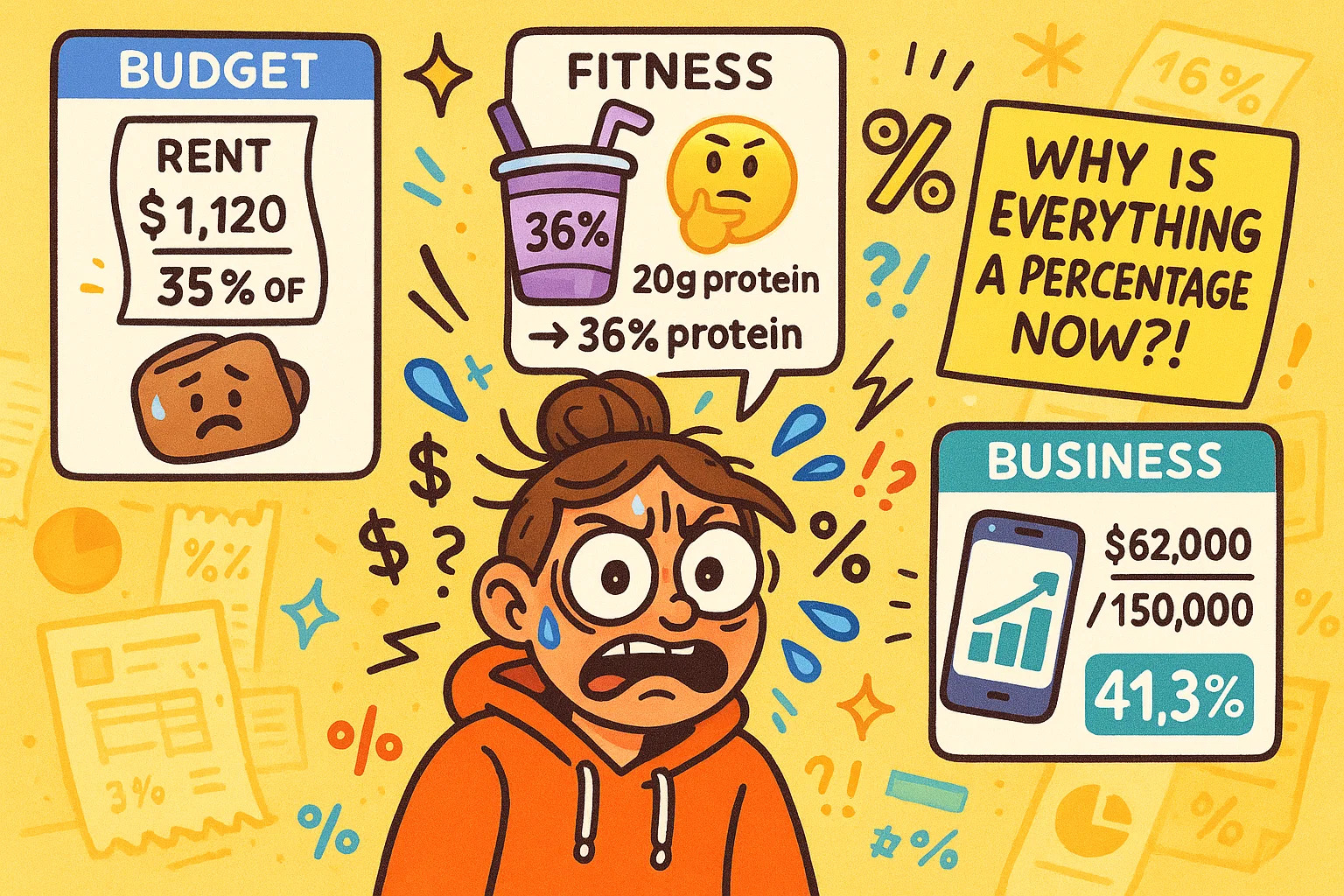Whether you're managing a project budget, comparing sales numbers, or double-checking your fitness goals, figuring out what portion one number makes of another is one of those small but mighty math moves. “Value as percentage of total” shows up everywhere — and doing it right means more clarity, more accuracy, and often, better decisions.
How We Naturally Use “Value as Percentage of Total”?
It’s one of those math concepts that quietly runs the background of your daily life — until it doesn’t. “Value as percentage of total” isn’t just a spreadsheet term. It’s baked into your budget, meals, metrics, and meetings.
Take budgeting, for instance. Let’s say your paycheck is 3,200,andyourrentis1,120. That’s 35% of your income gone — before groceries, gas, or that emergency vet bill. When that number creeps too high, financial stress isn’t far behind.
Or fitness. Maybe your post-gym smoothie has 220 calories and 20 grams of protein. Protein has 4 calories per gram, so that’s 80 calories from protein — just 36% of your shake. Want to bulk up? That number might be too low.
And in business? You’re not just looking at dollars — you’re tracking the share of mobile revenue in your total sales. If mobile made 62,000lastquarteroutof150,000 total, that’s a 41.3% share — and possibly a sign it’s time to invest more in mobile UX.
These small calculations often carry big decisions. And yet, we don’t always recognize them. A forgotten subscription or poorly measured metric can throw off the bigger picture. One bad percentage, and you’re wondering why the numbers don’t add up.
🔗 Need a quick way to double-check your figures? Try the Math Calculator to make sure your numbers are pulling their weight. Not sure how 32 is 40% of what? The Percentage Calculator can handle that instantly.

The Quick Math Behind It — And Why It Works
It’s one of the most versatile formulas in everyday math. When you want to know how much a number contributes to a total, you're using the value as percentage of total equation — even if you’re not calling it that.
The formula is straightforward: percentage = (part ÷ total) × 100
Let’s say you spent 850froma2,500 paycheck on rent. That’s:850 ÷ 2500 = 0.340.34 × 100 = 34%
So, 34% of your income goes toward rent — more than ⅓, which many financial experts consider a red flag for cost of living¹.
Here's another everyday example:
You eat a snack that has 14g of fat and 420 calories. Since fat has 9 calories per gram:14 × 9 = 126 calories from fat126 ÷ 420 = 0.30.3 × 100 = 30%
So, 30% of the snack’s calories come from fat — a quick check that tells you a lot more than just raw numbers.
Want to double-check with a formula version? It’s:
𝑃 = (𝑝𝑎𝑟𝑡 ÷ 𝑤ℎ𝑜𝑙𝑒) × 𝟣𝟢𝟢
Or, broken down:𝑃 = (𝐩𝐚𝐫𝐭 ⁄ 𝐭𝐨𝐭𝐚𝐥) × 𝟣𝟢𝟢
Still feel abstract? Here's a quick example using actual Unicode fractions:
If you scored ⅗ of the total points on a test, your percentage is:
⅗ × 100 = 60%
That’s what makes this formula so flexible — you can plug in raw numbers, decimals, or even fractions, and the result always translates to something people understand immediately. For fast answers on markdowns, the Discount Calculator works like magic.
How One Percent Changed a Nation
In 1974, a simple concept quietly entered U.S. tax policy — and ended up reshaping millions of lives. That concept? A refund based on a portion of what you earned — your value as a percentage of total income. It was the beginning of the Earned Income Tax Credit (EITC).
The EITC wasn’t designed just to hand out money. It calculated how much financial relief someone should receive based on how much they worked and earned. The more you made (up to a point), the more credit you received — but as a percentage of your income.
For someone earning $9,000 a year in the late 1970s, the EITC could return as much as 10–15% of their total income. That made a visible difference in grocery bills, childcare, and utility payments.
By 1993, the credit expanded to become the largest anti-poverty program in the U.S., lifting more children out of poverty than any other federal policy at the time. It wasn’t the raw dollar figure that mattered — it was what that number represented. For many families, receiving even ¹⁄₁₀ of their annual earnings back meant relief, freedom, and opportunity.
Today, the EITC remains a key tool in U.S. tax policy. And it still works because it’s rooted in the same principle: a number, seen in proportion to the whole, carries far more weight than we realize.
A few percentage points in tax credits, subsidies, or wage increases might seem small — until you realize they’re often the difference between barely getting by and breathing room.


